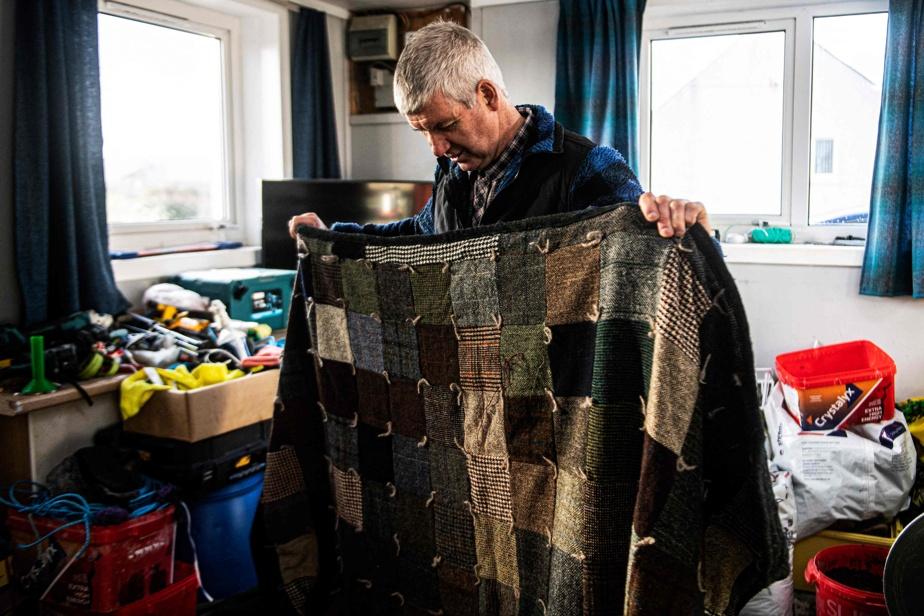Scottish tweed is on the rise |The press
(Ile de Lewis) Dans son petit atelier encombré de sacs de tissus, bobines et outils, Ian Mackay tisse patiemment une laine d’un vert éclatant. Une fois terminé, le tweed fabriqué chez lui, dans l’archipel écossais des Hébrides, sera peut-être expédié à l’autre bout du monde.
For the moment, this 51 -year -old weaver pedal to activate the weaving machine in a regular rattling, watching for possible defects.
"It's woven by hand ... well as you see, it is rather woven with your feet", he jokes in a voice marked by a strong accent of the Hebrides.
The 50 -year -old spins wool ten hours a day, no break on Sunday, a sacred day in this Scottish archipelago of some 26,000 inhabitants bathed in the Christian religion.
"There is no point in being very fast and making mistakes.It is better to do a slow and quality work, ”he suggests.
"No matter what bad weather when you wear," he also notes while in-: a freezing wind whipped the ocher reflections where sheep graze.
Originally from Scotland and marketed since the 1840s, the tweed has more than ever the wind: its ecological and durable side inspires creators concerned with being more respectful of the environment.

Made traditionally with 100 % pure wool virgin sheep, the tweed Harris is the only fabric protected by a law of the British parliament in 1993.This one stipulates that it must be "woven by hand by the islanders in them, in the external hebrides [...], from pure virgin wool tinted and spun in the external Hebrides".
Affixed on each piece, a logo made up of a globe surmounted by a cross certifies the origin and the authenticity of this fabric.
Ecological and sustainable
If it is originally associated with the aristocracy and the gentlemen-farmers who were bringing its resistant character to bad weather, ideal for a hunting or fishing game, the British designer Vivienne Westwood has long diverted this image in theIntegrating into the punk locker room.
Like her, other major brands make it a key element in their collections.
"We are fortunate to work with the most prestigious fashion houses in the world [...] like Chanel, Dior, Yves Saint Laurent, Hermès", quotes Margaret Macleod, director of sales of Harris Tweed Hebrides."Recently, we worked a lot with Polo Ralph Lauren in the United States," she added, showing the company factory, located by a lake in Shawbost, in the west of the'Island of Lewis.
Seventy people work in this tweed factory.The wool is shade and spun then sent to some 120 weavers at home.Once the tweed has been woven, he will return to the factory to be washed, dried and undergo the last finishes.
A third of the production of the Shawbost factory goes to the United Kingdom while two thirds are exported to the four corners of the world.
"We export to France, Germany, Italy and many other European countries.We also have strong export activities in South Korea, Japan and the United States, and China has also become a new market, "lists the sales director.
From Chanel to Nike
In total, some 160 home weavers live in the Hebrides, working hand in hand with three factories that produce a total of 1.5 million meters per year.
The tweed is used in the manufacture of jackets, pants, coats, but also shoes, handbags, armchairs or even teddy bear.
About fifteen years ago, the Nike sportswear brand chose the Harris Tweed for a collection of "trainers", a huge advertising for the artisans of Hebrides.
More recently, the public rediscovered it in favor of very popular television series: aristocrats from Downton Abbey to the gangsters of Peaky Blinders via the royal family in The Crown, everyone carries the tweed which is declined in dozens ofpatterns (tiles, chevrons, pieds, etc..) and different colors.
Green foam, indigo, cherry red, daffodil ... "We start with about 60 colors and we mix each of these colors to create more than 180 shades of different wire", describes Margaret MacLeod.
A range of colors inspired by the landscape of these remote islands, golden brown of the moor to blue of the Atlantic Ocean.
Selon Mme Macleod, les stylistes sont attirés par les « couleurs » et « l’authenticité », et « ils veulent aussi capturer un petit bout des Hébrides extérieures ».








